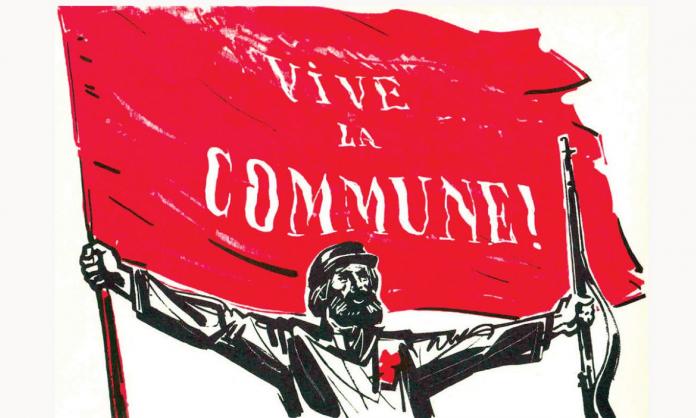“The workers of Paris, amidst the failures and treasons of the ruling classes, have understood that the hour has struck for them to save the situation by taking into their own hands the direction of public affairs … They have understood that it is their imperious duty, and their absolute right, to render themselves masters of their own destinies, by seizing upon the governmental power.”
—Manifesto of the central committee of the Paris Commune
It all began as the sun rose over the district of Montmartre and Belleville on 18 March 1871. Army soldiers began seizing nearly 250 cannon that had been placed in these radical, working-class areas by the National Guard, a popular Parisian militia. The soldiers had been sent by the head of the new republican government, Adolphe Thiers. Anger with Thiers—widely despised for his role in the brutal suppression of a rebellion in which workers had played a key part in 1848—was intense. He had gone to war with Germany the previous July for the glory of the French empire. Confronted with defeat, he baulked at the idea of arming the population of Paris. And the bourgeoisie refused to support any defence of Paris while the National Guard, with its working-class membership, remained in control of armaments.
Belleville and Montmartre were described by a commentator of the time as “rugged open spaces where the lawless crowds of these parts love to hold their meetings and park their cannon”. And Belleville was “the most solidly working-class district in all of Paris, and the most revolutionary”. The cannon were regarded as their cannon, financed by workers’ subscriptions to the National Guard since the revolution of 1848. And they were the only means of defence against the Prussian army shelling the city since Thiers had moved his troops to Versailles.
Contrary to Thiers’ expectation, the guardsmen began fraternising with soldiers, who then began turning their rifles up as the streets rang with declarations of Vive la République! Hostile crowds quickly gathered to block the soldiers trying to move the cannon. Eyewitness accounts all draw our attention to the large numbers of women and children. A Versailles army officer recorded that, where he was in charge, they were “stopped by a crowd of several hundred local inhabitants, principally children and women. The infantry detachment which was there to escort the cannon completely forgot their duty and dispersed into the crowd, succumbing to its perfidious seductions, and ending by turning up their rifle butts”.
The crowd swelled, transforming itself from a mass of spectators into increasingly angry and active participants. The London Times correspondent recalled that by midday“barricades were springing up in every direction … Instead of a government blocking every street as was the case in the morning, a hostile cannon was now looking down every street”. General Vinoy, assigned to capture the cannon, was fleeing Paris.
Over the next 72 days, there were truly awe-inspiring achievements. The experience of taking control over their society inspired mass involvement in debates about all aspects of their lives. They vigorously attempted radical reforms in the family, the conditions of women, in the workplace and education as they debated the role of science, religion and the arts in society.
Workers created the most democratic institutions known to humanity at that time. The old state power had been demolished, a significant move that Karl Marx emphasised:
“For the first time since the days of February 1848, the streets of Paris were safe, and … without any police of any kind … Paris could resist only because, in consequence of the siege, it had got rid of the army, and replaced it by a National Guard, the bulk of which consisted of working men. This fact was now to be transformed into an institution. The first decree of the Commune, therefore, was the suppression of the standing army, and the substitution for it of the armed people.”
This revolutionary move was the basis on which the new democracy could be built. The Commune committee’s members were largely drawn from the working class, elected by universal suffrage, and were charged with both making and enforcing the new laws governing the city. Judges were also elected. All public servants could be recalled and replaced at any time. Historians have documented the incredible flowering of organisation, debate and social experimentation that took place.
The Jewish-Hungarian worker, Léo Frankel, a collaborator of Marx, was appointed minister of labour to deal with workers’ rights and working conditions. Night work by bakers was abolished; employers were banned from reducing wages by levying fines on their employees under any pretext. Military supplies were obviously of paramount importance. In response to the workers, new contracts specifying a satisfactory minimum wage were agreed. The employers were not consulted.
The Russian socialist Elisabeth Dmitrieff was central to establishing the Union des Femmes, or Women’s Union. It met daily in almost every one of the twenty districts. The membership was dominated by workers in the garment trades: seamstresses, laundresses, dressmakers and so on.
The Union des Femmes’ discussions included theoretical questions about ending private property and the issues of gender-based inequality, as well as solving the day-to-day struggle to provide fuel and food to families. At the same time, they participated in the defence of the Commune, maintenance of barricades, tending to the sick and wounded. Spelling out their mission, the Union des Femmes declared: “We want work, but in order to keep the product. No more exploiters, no more masters. Work and well-being for all”. At their urging, the Commune set up cooperatives to make guardsmen’s uniforms, which provided well-paid work under the women workers’ control.
The tradition of radical political clubs, inspired by the 1789-92 revolution and revived in 1848, had emerged from the underground prior to the Commune. They discussed a wide range of issues: political strategy, which reforms to prioritise, women’s rights, attitudes to the church and science, how to better organise defence and strengthen the barricades and more. Workers were the great majority of participants, but middle-class radicals also joined in. Between 36 and 50 clubs met daily, mostly in the working-class districts. Some were huge, involving thousands, with women playing a prominent role both in their own clubs and in mixed ones with men.
Élie Reclus, an ethnographer given responsibility for the management and preservation of the Bibliothèque Nationale, called them “schools for the people”, where constructive debate flourished and a heightened sense of community was created. A week after the declaration of the elected Commune committee, on the initiative of the clubs, churches across the city were commandeered as meeting places and organising centres. These venues, unlike street meetings, created a sense of seriousness and permanence in the clubs.
It is wonderful to imagine such revolutionary proceedings taking place beneath soaring ceilings and beautiful stained glass windows. Occupying these odes to privilege and power was a constant reminder of the momentous challenge the Commune had thrown down before the bourgeoisie, the monarchy and their ally, the church. As one historian writes: “The church’s close association with people of means had long drawn popular ire; the birth of the Commune merely unleashed it”.
There were no bounds to the irreverence displayed once the churches were commandeered. Holy water replaced with a pile of tobacco, statues of the Virgin Mary dressed in the uniform of women supplying provisions to the National Guard, sometimes with a pipe in her mouth. At the same time, the Communards in many cases allowed ceremonies for the devout to go ahead in the mornings before the clubs met. As such, the meetings would often take place amidst flowers, crucifixes and other religious paraphernalia left behind from morning mass and other religious events.
In a reversal of the old order, speakers in the clubs insisted that the clergy pay rent to the Commune for use of ecclesiastical spaces for “their comedies”. Proceeds were to go to the widows and orphans of those who died defending the Commune. The club of Faubourg Saint-Antoine suggested that church bells be melted to make cannon.
A third of children had no access to education at all, and the Commune would try to implement compulsory and equal education for both boys and girls. Teachers’ wages were raised, with women and men on equal pay. A school of industrial arts was established with a woman as director. Students would receive scientific and literary instruction, then use some of the day for the application of art and drawing to industry. Unlike today, theoretical and practical debates about education were not carried out in the rarefied circles of academia, but in the clubs around the city. Declarations reflecting those debates were printed as posters and pasted on walls in the streets. One read in part:
“That each child of either sex, having completed the cycle of primary studies, may leave school possessing the serious elements of one or two manual professions: this is our goal … the last word in human progress is entirely summed up by the simple phrase: Work by everyone, for everyone.”
Women were involved in pushing many of the Commune’s most radical proposals. This is not surprising. Women, due to the specific nature of their oppression, can be the bearers of more conservative ideas in stable times, especially when trapped in the home. But when they challenge their chains of oppression, they often become the most dynamic element of mass movements, with less to lose and more to gain from a fundamental transformation of the status quo.
The Commune immediately made far-sighted and fundamental improvements to women’s lives. The remission of rents and the ban on sales of goods deposited at the pawn shops lifted a huge burden from workers’ families. A decree on 10 April granted wives of guardsmen who were killed defending the Commune a pension and each of her children, “legitimate” or not, could collect an allowance until they turned 18. About one-quarter of all couples were unmarried, but they were not recognised by the church or the state, denying women their dignity, to say nothing of economic discrimination given that unmarried women were not eligible for any widow’s allowance.
———-
Marx had argued that we make our own history, but not in circumstances of our choosing. The uprising that erupted on 18 March forced the Communards to reorganise society amidst a Prussian siege and a bitter civil war. These factors strongly contributed to the defeat of this heroic uprising.
On Sunday 21 May, troops from Versailles stormed Paris. New barricades went up in street after street, as the population mobilised for a final heroic attempt to maintain their Commune. An eyewitness described how one of the barricades was constructed and defended by “a women’s battalion of around 120. At the time that I arrived, a dark form detached itself from a carriage gate. It was a girl with a Phrygian bonnet over her ear, a musket in her hand, and a cartridge-belt at her waist. ‘Halt, citizen, you don’t pass here!’”
Just one week later, 30,000 or more people had been murdered by the counter-revolutionaries. The chapter headings used by Lissagaray—a participant and author of one of the first books on the Commune—sum up the experience: “The Versailles fury”, “The balance sheet of bourgeois vengeance”. The essence of the events is captured in the title of historian John Merriman’s book, Massacre. Many casualties were never recorded, their bodies thrown into mass graves and later incinerated. Countless others disappeared into jails or colonial transportation, where who knows how many died. Others fled to seek sanctuary, and there are few records of who survived wounds inflicted in the fighting.
This barbarity was at first cheered on in the respectable bourgeois papers of Europe, whose journalists had followed the army around “like jackals”. One journalist had called for “an end to this international democratic vermin” of red Paris. But faced with “the smell of carnage”, swarms of flies on corpses, trees stripped of leaves, the streets full of dead birds, even some of these bourgeois commentators were repulsed. “Let us not kill any more”, pleaded the Paris Journal, “Enough executions, enough blood, enough victims” lamented the Nationale.
But the upper classes who lived off the labour of those being massacred set no such limits to their savagery. Respectable women took tours of the dungeons where the arrested were incarcerated, holding their lace-edged handkerchiefs—made by the women at whom they gawked—to their noses against the stench of filth and dying Communards. In particular, they took delight in poking the women with their parasols. Many public figures, including judges and other respectable bourgeois and middle-class types, continued to bay for blood. To justify this frenzy, they invented lies which appealed to the prejudices of this scum. The ruling class especially hated the women Communards, whom they depicted as “vile”, “wild” and sexually depraved.
Their fury was stoked by hysterical stories of the infamous pétroleuses, supposedly prepared to burn down the whole of Paris. The Communards clearly did use fire as a weapon of war to destroy buildings from which the Versaillese could gun people down. Fire was also used as a form of barricade, a wall of flames to keep the soldiers back, set by the fighters who must have included women and possibly even children.
The heroism of children, women and men as they fought to defend their “Communal luxury”, the term used by Eugène Pottier, author of the now famous revolutionary anthem, “The Internationale”, in his founding document of the Artists’ Federation, would live on in the memory of the socialist movement and workers. Fighting and dying became a sign of revolutionary honour. A doctor commented on the bravery of the Communards: “I cannot desire the triumph of your cause; but I have never seen wounded men preserve more calm and sang-froid during operations. I attribute this courage to the energy of their convictions”.
And this is how the Commune’s supporters interpreted the courageous resistance. It inspired generations, illustrating why the sentiment “It is better to die fighting than to live on your knees” is the most principled response to ruling-class barbarism. If they had meekly surrendered in the name of avoiding violence, there is no evidence that lives would have been saved, and the revolution would surely not have inspired generations of working-class and socialist activists.
In spite of the efforts of the descendants of the butchers who saturated Paris in blood, the memory of this first workers’ revolution cannot be completely suppressed. For decades, workers remembered the Communards’ courageous defiance. On May Day 1901, thousands of mourners joined the funeral procession for Paule Mincke, Marx’s collaborator, through the streets of Paris. They chanted “Vive la Commune!” and “Vive l’Internationale!” as more than 600 police, 500 soldiers and 100 cavalry guarded the streets against any possibility of a repeat of 1871 as workers remembered this woman who had opened one of the first schools for girls in France, for which she had requisitioned a Jesuit school.
More than 100,000 attended the funeral of Louise Michel, perhaps the most flamboyant and legendary figure of those 72 days, in Paris in 1905. Socialists and anarchists celebrated the Commune every March. The ghastly images of tortured women beamed around the world by the bourgeois press could not undercut the sense of pride and solidarity that their courage inspired. In the New South Wales mining town of Broken Hill, for at least a decade into the twentieth century, the Socialist Sunday School organised the annual anniversary commemoration of the Commune.
The Paris Commune reminds us that the fine and spiritual aspects of life we hunger for can be won only by the struggle for the rough, material things that make them possible. And, in the words of Walter Benjamin, “they are present as confidence, as courage, as humour, as cunning, as steadfastness in this struggle”. That is why the Paris Commune still commands our attention, why it still has the power to inspire our confidence in the working class to create a “Communal luxury” for humanity.
First published on 18 March 2021 by Redflag.org.au. This is an edited extract from Sandra Bloodworth’s “Celebrating the Paris Commune of 1871: ‘Glorious harbinger of a new society’”, published, with references, in the latest edition of the Marxist Left Review.








